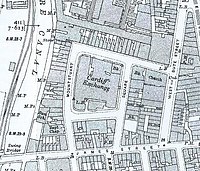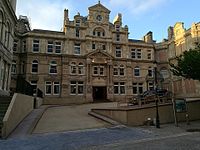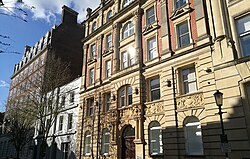|
Mount Stuart Square
Mount Stuart Square is a residential and commercial square in Cardiff, Wales. It is located in the Butetown area of the city. Originally developed in the late 1800s as a residential location for nearby dock workers, it quickly became a centre for upscale residential properties which revolved around the main square. By 1900, commercial activity had taken its place, dominated by the Coal Exchange, which occupied the once open central space. The square contains a high concentration of listed buildings, which represent a range of architectural styles and some of Cardiff's finest examples of late 19th and early 20th century commercial architecture. Mount Stuart Square area was designated a Conservation Area in July 1980.[1] GeographyThe area which Mount Stuart Square currently occupies was originally coastal mudflat.[2] In its present form, it is an urban area, bordered by the A4119 James Street, a major road to the south, early twentieth century social housing to the north (on a site which had previously been used as a rail yard), historic commercial properties to the east on West Bute Street, and the historic Glamorganshire Canal to the west. The canal was drained in December 1951 when a steam suction dredger crashed into the inner lock gates, forcing them to collapse, and all the water was released into the estuary.[3] The gates were never repaired, and for a number of years the canal remained dry until the land was filled in and converted to parkland, named Canal Park. The square lies approximately half a mile to the south of Loudoun Square, which was also built as a residential square but never developed a commercial hub. Junctions with James Street and West Bute Street provide vehicular access to the square, and pedestrian access exists to the parkland to the west. The square has a one way traffic system, where vehicles enter at the junction with James Street to the south west, and exit via either James Street or West Bute Street. Mount Stuart Square has a distinctive form with buildings on four sides facing the Cardiff Coal Exchange building in the centre. It is not a square in the true sense because the building area was limited by the physical restrictions of the canal to the west. The nearest railway station is Cardiff Bay. History The development of Mount Stuart Square is closely linked to that of the coal industry in South Wales. The mining of coal in the South Wales valleys in the 1790s onwards meant that Cardiff developed into a port through which the coal was shipped and exported worldwide. It was initially transported using the Glamorganshire Canal, and later by rail on the Taff Vale Railway, both of which terminated close to the site of the square. A number of docks were constructed to facilitate the movement of this coal, and the entire Butetown area of Cardiff was transformed to accommodate the new industry.[1] By the 1830s, Cardiff became the pre-eminent iron-exporting port, shipping almost half of British overseas iron exports; between 1840 and 1870, the volume of coal exports increased from 44,350 to 2.219 million tonnes.[4] The population of the area increased accordingly, and a grid pattern residential suburb for port-related workers was built on land which included the site of the square. In its original form, Mount Stuart Square was a residential square with a central garden. It was constructed in 1855 as a select residential enclave around ornamental gardens for merchants and sea captains, and originally consisted of 45 stuccoed three-storey town houses.[5] The land had originally been mudflats, but later the Cardiff Glassworks had partially occupied the area. As a result, the underlying soil was a mixture of alluvial mud and slag from the glassworks, which required 30 feet concrete shafts to be constructed that rested on a bed of hard gravel in order to construct the foundations of the square.[2] In the period immediately before construction of the square commenced, the land was used as stables for canal horses[6] Named after Lord Mountstuart,[7] the area was the vision of the second Marquess of John Crichton-Stuart, 2nd Marquess of Bute, who wanted to create a grand Georgian space to rival Berkeley Square in London.[8] The development of the square was part of his vision to transform Cardiff into a major port, improve the value of his lands in Cardiff itself and increase the value of the royalties he could charge on his coal fields.[9] As the docks rose in prominence, wealthy residents moved out and it became a commercial centre. The construction of the Coal Exchange building between 1884 and 1888 by Edwin Seward solidified the change in focus to commercial, and it became central to the coal trade activity in Cardiff docks for much of the early part of the 20th century.[10] Built to provide a dedicated location for merchants and traders to sell coal, it followed construction of buildings of a similar function in London, Liverpool and Manchester.[2] It was constructed in stages, the central trading hall and east block completed first. The London and Provincial Banking Company occupied the majority of the north side.[2] In 1904 the world's first recorded £1m deal was struck there.[10] Those of the original town houses not converted were replaced by purpose-built offices for coal and shipping firms. The buildings surrounding the Coal Exchange housed coal companies, banks and agents.[11] Most of Cardiff's notable architects of the period are represented including Alexander Roos, architect to the Bute Estate, Edwin Seward, E W M Corbett, W D Blessley, Teather and Wilson, Ivor Jones and Percy Thomas, and Henry Budgen.[1] The impact of WW1 was significant on the square, having a damaging effect on the coal industry. By 1921, only six of the 52 companies operating in 1888 were still in business, with the industry never recovering.[8] The Coal Exchange closed in 1958, which in turn reduced the demand for commercial premises on the square and allowed boarding houses to be established.[12] By the early 21st century, all banks had vacated their properties on the square. The western side of the square saw a gradual demolition of original properties, and by the 1990s was no longer enclosed on its border with the canal. Much of the land was being used as open air carparks, until the construction of St James and St Stephens Mansions, and later the Casablanca Building, which once again enclosed the square. Current statusArchitecture The majority of buildings throughout the square range from 3 – 5 storeys, however; some of the surviving domestic buildings are 2-storey. The later commercial buildings are significantly larger than the former houses, both in height and overall mass. The streets are relatively narrow in relation to the large commercial buildings. A key characteristic are the variances in the scale between buildings. This is especially dramatic where the remaining 2-storey buildings are side by side with imposing 5-storey commercial buildings.[1] St Stephens and St James Mansions are large high rise residential buildings constructed in 2003, which occupy a large section of the north western part of the square. The Coal Exchange building is of a French Renaissance style, and occupies a central position in the square, rising to five storeys. OccupancyThe square has a mixed commercial, hospitality and residential occupancy. It is home to a number of media, marketing, financial, legal and not for profit organisations, including the Wales Council for Voluntary Action,[13] The Royal College of General Practitioners Wales,[14] and Literature Wales.[15] Organizations working with the education sector include the Quality Assurance Agency for Higher Education[16] and the National Union of Students Wales.[17] There are a number of establishments serving food and drink. The Royal Thai Consulate[18] and the Mexican Honorary Consulate in Cardiff[19] have offices in the square. The Exchange Hotel operates from the former Coal Exchange building in the centre of the square.[20] Places of worship Mount Stuart Square has been home to a number of religious buildings, in addition to its function as a residential and commercial space. The only remaining building is St Stephens Church, designed by architect E. M. Bruce Vaughan and constructed between 1900 and 1902. It is located at the junction with West Bute Street. Designed in a Gothic style, the parish was deconsecrated in 1992.[21] Between 2003 and 2009, the building was used as a live music venue called The Point.[22] The Bethel English Baptist Chapel, located near the southern entrance to the square, was built in 1858 and renovated in 1898 and again in 1910. It was brick built in the Classical and Lombardic/Italianate style over two storeys, and was the location of Ivor Novello's baptism.[23] This chapel closed in 1965 and the Casablanca Club operated from the site from 1965 to 1985.[24][25] It was demolished in the 1990s, the land used as a carpark until in 2021 when construction completed on the Casablanca Buildings, a boutique high-rise apartment block.[26] The Siloam Welsh Baptist Chapel in the northeast corner next to Lloyds Bank, was opened in 1859, but in 1902 converted into a commercial building known as Phoenix House, which retained the majority of the original building except the font wall.[27] The Mount Stuart Welsh Independent Chapel, now demolished, was built in 1858 and rebuilt in 1864 to the design of architect Thomas Thomas of Landore.[28] Future developmentsIn 2016 it was announced that the Coal Exchange was to be fully refurbished as a hotel, with a museum detailing the history of the building and of the Cardiff Docks.[29] In 2009, Cardiff Council identified a number of challenges facing the square, including a loss of architectural detailing, a need to improve physical access to some buildings, a number of underused or vacant listed buildings which show signs of serious deterioration.[1] In 2017, a call was made to house a gallery or museum in one of the buildings on the square, with the aim of being a catalyst for regeneration.[30] Cultural referencesThe location is regularly used by the BBC for filming, including Dr Who,[31] Torchwood, Casualty, Upstairs, Downstairs[32] and Sherlock. The film The Vision was filmed on site at the Coal Exchange building on the square.[33] In 1988 the building was re-acquired and subsequently completely refurbished in 2001 to turn it into an entertainment venue. It hosted acts such as the Arctic Monkeys, Manic Street Preachers, Ocean Colour Scene, Stereophonics and Biffy Clyro.[34] The Casablanca Club operated from the Bethel English Baptist Chapel from 1965 to 1985, attracting an audience from the diverse Butetown area and beyond, and recognised as one of the biggest centres of R&B outside of the US. It hosted international artists Aretha Franklin, Jimmy Ruffin and Spandau Ballet, as well as Welsh performers Mickey Gee, Endaf Emlyn and Geraint Jarman.[25] In 2014, the Wales Millennium Centre hosted a production entitled 'Night at the Casablanca', which was a celebration of the musical tradition of the venue.[35][36] The Point was a live music venue which operated from St Stephen's Church from 2003 to 2009. It hosted acts including Super Furry Animals, Franz Ferdinand, DJ Danger Mouse and The Bluetones.[37] In 2016, filmmaker Nick Broomfield visited the square as part of his documentary Going Going Gone, which investigated the deterioration and heritage of the Coal Exchange building.[38][39] In June 2017, the BBC broadcast a documentary entitled Saving The Coal Exchange, which looked at the development of the building into a luxury hotel.[40] In September 2017, BBC Wales broadcast a documentary called Cardiff Bay Lives, which featured residents and businesses from the square.[41] Notable buildings 

References
External links
Wikimedia Commons has media related to Mount Stuart Square. |
||||||||||||||||||||||||

